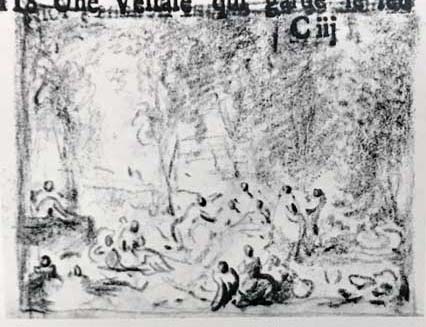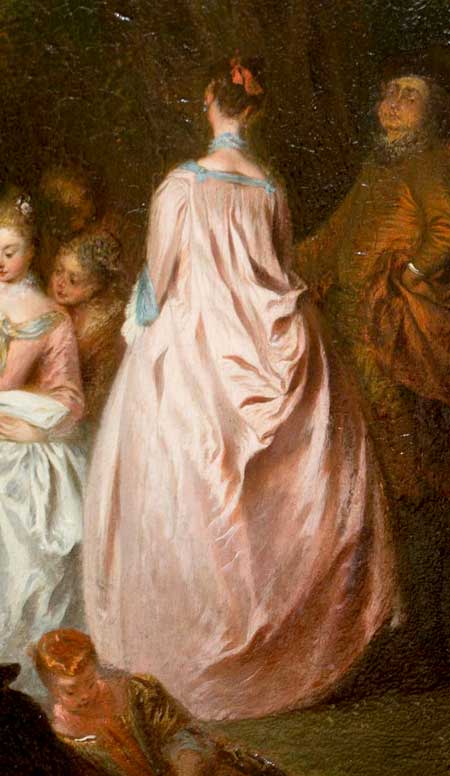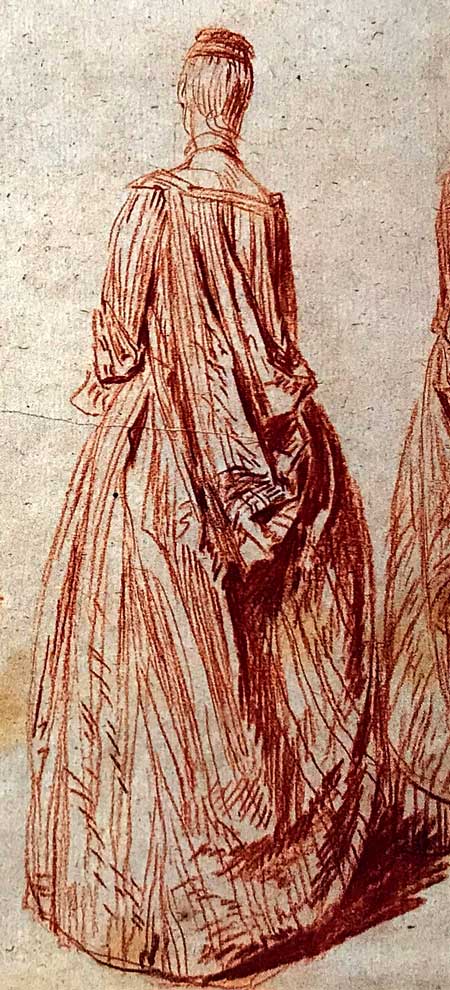
- Home Page
- Accepted
Paintings & Copies - Doubtful
Attributions - Doubtful Textual References
- Alternative
Titles - Collectors &
Museums - Bibliography
- Search Abecedario
- Watteau &
His Circle
X. Une Fête champêtre dans un beau jardin
Entered July 2017
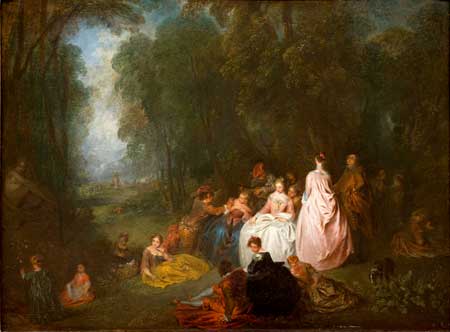
Chicago, Art Institute of Chicago, Max and Leola Epstein Collection, inv. 1954.295.
Oil on oak panel
48.4 x 64.5 cm
ALTERNATIVE TITLES
Conversation dans un jardin
Conversation dans une campagne
Festival in a Park
Fête champêtre
Fête galante an der Statue einer sitzenden Frau
PROVENANCE
Paris, sale, December 20-23, 1773, lot 117: “A. WATEAU. Hauteur 17 pouces, sur 23. VINGT-SIX figures de 5 pouces de proportion, occupés à chanter, à jouer & à se promener dans différens endroits d’un Parc très-orné d’arbres. La belle couleur rend ce Tableau un des plus capitaux qui sont connu de ce Maître.” According to an annotated copy of the sale catalogue in the Rijksbureau vor Kunsthistorische Documentatie, the painting was bought by Madame du Barry, comtesse du (1743–1793) but this has been questioned, not least of all because the painting appeared on the market just five years later.
Gabriel de Saint-Aubin attended the 1773 sale and, as he often did, made marginal sketches of many of the paintings. His copy of that catalogue is now in the Bibliothèque nationale. Although his drawing after the so-called Watteau fête galante has minimal detail, still, it matches up with the painting now in Chicago.
Paris, with Antoine Charles Dulac or a Monsieur La Chaise. Their sale, November 30ff, 1778, lot 395: “ANTOINE WATTEAU ET PATER. Peint sur bois, large 23 pouces, haut 18. Une Fête champêtre dans un beau Jardin; ce Tableau, d’une Ordonnance de composition très-agréable, ne laisse rien à desirer, tant par la beau ton de couleur que par la touche spirituelle; plusieurs parties font croire que ce Tableau a été commencé par Watteau, & terminé par Pater.” The painting sold for 963 livres according to an annotated sale catalogue in the Rijksbureau vor Kunsthistorische Documentatie. The purchaser was Jean-Baptiste Guillaume de Gevigney.
Paris, collection of Jean-Baptiste Guillaume de Gevigney (1729-1802; Généalogiste au service du comte de Provence, Garde des titres et généalogies de la Bibliothèque du Roi ). His sale, Paris, December 1-29, 1779, lot 530: WATTEAU ET PATER . . . Une Fête champêtre donné dans un beau Jardin. Ce Tableau, dont la plus grande partie des figures a été peinte par Watteau, & la reste par Pater, est de la plus belle ordonnance, & ne laisse rien à desirer. Toile. H. 18 p. l. 23.”
Paris, collection of Daniel Saint (1778-1847; miniaturist). His sale, Paris, May 4, 1846, lot 57: “DU MÊME [WATTEAU] . . . Le concert dans le parc. Dix-neuf personages diversement groupés animent cette charmante composition. Dans le groupe principal, on remarque parfaitement éclairé, une jeune femme en gallant costume, corsage de satin rose et jupe de satin blanc; elle tient sur ses genoux un livre de musique, dans lequel elle paraît chanter; un homme placé près d’elle, et jouant de la guitare semble l’accompagner. Un peu plus loin un homme et une femme se promenent et causent; à droite une jeune fille se défend des caresses d’un jeune homme. Ce tableau, l’un des plus terminés du maître, a été fait à Nogent-sur-Marne, village qu’habitait Watteau, qui s’est plus à représenter sous les habits d’un de ses personages, le portrait du cure de l’endroit.” According to an annotated copy of the catalogue in the Frick Art Reference Library, New York, the painting sold for 4,900 francs. According to Hédouin, the picture was bought by M. Mennechet. Likewise, an annotated copy of the catalogue in the Bibliothèque nationale cites the same price and buyer's name. Others have suspected that it was bought on behalf of the fourth Marquess of Hertford, who also purchased Watteau’s La Perspective at the Saint sale.
Paris, collection of Richard Seymour-Conway, 4th Marquess of Hertford (1800-1870). By descent to his illegitimate son, Sir Richard Wallace.
Paris, collection of Sir Richard Wallace, 1st Baronet (1818-1890); by descent to his widow, Julie-Amélie Charlotte Castelnau Wallace (d. 1897); by descent to Sir John Murray Scott.
London, collection of John Murray Scott (1847-1912, secretary to Sir Richard and Lady Wallace). His sale, London, Christie’s, June 27, 1913, lot 134: “J. B. PATER. . . A FÊTE CHAMPÊTRE / A large company of ladies and gentlemen, gaily attired, are assembled in an open glade in a wood; some are singing, while others are conversing; on the right is a statue of Venus, and in the distance is a town near a lake / On panel—18¾ in. by 24½ in. See Illustration.” According to an annotated copy of the sale catalogue in the Watson Library, Metropolitan Museum of Art, New York, the picture was bought for £2,415 by Agnew.
London, Agnew’s. Sold to Walter S. M. Burns in 1919. The sale is recorded in Christie’s records, as conveyed in a letter dated April 7, 1981, from William Joll of Agnew’s to Mary Kuznia of the Art Institute of Chicago.
North Myms Park, Hatfield, collection of Walter S. M. Burns.
London, Christie’s, sale, June 20, 1930, Property of a Lady (Burns’ widow?), lot 106: “N. LANCRET. . . . A FÊTE CHAMPÊTRE / A large company of ladies and gentlemen, gaily attired, are assembled in an open glade in a wood; some are singing, while others are conversing; on the right is a statue of Venus, and in the distance is a town near a lake / On panel—18¾ in. by 24½ in. From the Collection of Sir John E. A. Murray Scott, Bart, 1913 / See Illustration.” According to an annotated copy of the sale catalogue in the Watson Library, Metropolitan Museum of Art, New York, the picture was bought for £3045 by Frank T. Sabin.
London, Frank T. Sabin. Sold in 1934 to Leola and Max Epstein.
Chicago, collection of Leola Epstein (1888-1968) and Max Epstein (1875-1954; industrialist). Bequeathed to the Art Institute of Chicago in 1954.
EXHIBITIONS
Manchester, Art Treasures of the United Kingdom, Exhibition, 1857, cat. 29 (as by Pater, Fête Champêtre, lent by the Marquis of Hertford).
London, Bethnal Green, Paintings, Porcelain, Bronzes (1872), cat. 436, (as by Pater, Pleasure Seekers, lent by Sir Richard Wallace).
Horticq, Le paysage français de Poussin à Corot (1926), no. 249 (as imitator of Watteau, Fête Galante, lent by Walter S. M. Burns, London).
Chicago, University of Chicago, Renaissance Society, Max Epstein Memorial Exhibition (1955), cat. 13 (as by Pater).
Chicago, Art Institute, Selected Works of 18th Century French Art (1976), cat. 4 (as imitator of Watteau, Fête Champêtre).
New Light on Old Masters (Art Institute of Chicago: 1996).
SELECT BIBLIOGRAPHY
Hédouin, “Watteau,” 1845, no. 137.
Hédouin, Mosaïque (1856), cat. 148.
Waagen, Treasures of Art in Great Britain (1854-57), 4: 84.Goncourt, Catalogue raisonné (1875), 162.
Joubin, “Un Catalogue de vente” (1925), 336.
Ingersoll-Smouse, Pater (1928), cat 81.
Adhémar, Watteau (1950), cat. 247, 256, 314.
Sweet, “Great Chicago Collectors” (1966), 203-05.
Macchia and Montagni, L’opera completa di Watteau (1968), cat. 2OD, 2OG.
Ingamells, Wallace Collection, French (1989) p. 388, cat. 118.
Wright, The World’s Master Paintings (1991), 1: 455; 2: 62, 607.
Feinberg and Zuccari, “A Rediscovered ‘Fête champêtre’” (1997), 236-47.
Wise and Warner, French and British Paintings (1997), 159-69.
“Chicago: Un Pater devient un Watteau”(1997), 2.
Eidelberg, “Watteau at Chicago” (1998), 268-69.
Vogtherr, Französische Gemälde (2011), 225-26.
REMARKS
The attribution of this attractive painting has been problematic throughout its long history. Although it has been admired by many viewers, few agree as to whether it is by Watteau or Pater, or the two working in tandem. Some have thought that it was painted by a follower of Pater, and even Lancret’s name has been proposed. I believe it was painted in its totality by Pater.
The problem extends back to the late eighteenth century. By 1773, when the picture was in a sale organized by the noted dealer and expert Jean-Baptiste Pierre Le Brun, the true authorship of the painting had apparently been lost. Le Brun, impressed by its quality and color, tried selling it as a work by Watteau. Yet this must have been doubted by others, and just five years later when it was again put up at auction, it was asserted that while most parties agreed that it may have been begun by Watteau, it was finished by Pater. Clearly, the Parisian connoisseurs disagreed about the attribution. The idea of double authorship was claimed the following year when the picture was auctioned a third time. Here it was claimed that the greater number of figures were executed by Watteau, and the remainder by Pater.
The painting’s whereabouts and attribution during the Revolution and the Empire cannot be traced. It resurfaced during the Restoration, when it entered the collection of Daniel Saint. He was passionate about the paintings of Watteau and his school, but he did not carefully discriminate between the master and his imitators. Saint thought this picture was wholly by Watteau, and it was much admired by critics. Hédouin, for example, thought that it was one of Watteau’s most remarkable works, painted at the end of his life when he was residing at Nogent-sur-Marne, and that the artist had painted a portrait of the village’s priest (presumably the man standing at the right).
Even when the picture was later in the collection of its next owner, Lord Hertford, and the attribution was reversed again to Pater, its beauty was still praised. Waagen saw it under Pater’s name, and praised it in hyperbolic terms: “In every respect—composition, power, clearness of coluring, and finish—this is the finest picture I know by the master.” The attribution to Pater remained in place through the rest of the nineteenth century and well past the middle of the twentieth. Interestingly, Ingersoll-Smouse rejected the attribution to Pater but it is not clear that she saw it firsthand.
The painting was still catalogued under Pater’s name when it entered the Art Institute of Chicago, although there were occasional demurs as to whether it was by the artist himself or his school. When queried, most scholars saw the hand of Pater. In 1997, Feinberg and Zuccari with great bravado announced that they had “rediscovered” a Watteau and published their findings both in an entry in a new catalogue of the Art Institute’s collection, and in a separate article in Burlington Magazine. Prior to publication, they discussed the issue with various scholars. Margaret Morgan Grasselli and Philip Conisbee were of the belief that the painting had been begun by Watteau and finished by Pater, while Colin Bailey and Alan Wintermute saw more of the hand of Pater or another artist. None of these scholars were aware of the 1778 and 1779 sales, where the attribution had been adjusted away from Watteau to a partnership with Pater. But history had curiously repeated itself.
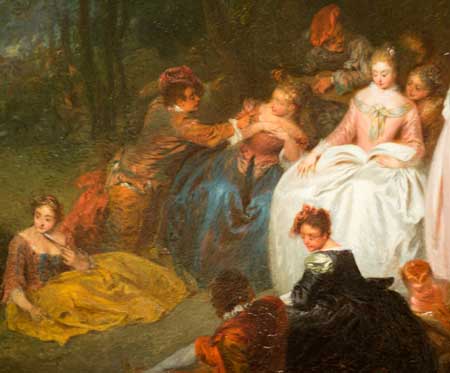
Jean-Baptiste Pater, Une Fête champêtre dans un beau jardin (detail)
Disregarding for a moment the history of this painting, its provenance, and its disputed attribution, we should consider the painting on solely optical grounds. The figures speak the pictorial language of Pater. The bland face of the woman holding a scorebook is clearly not on the same level as the poetically expressive faces of Watteau. The woman holding her fan to her chin is vapid. But if these characters are not equal to Watteau’s skill, they are identical to Pater’s.
In making their case for Watteau’s authorship, Feinberg and Zuccari pointed out that the woman at the right, seen from behind, is closely dependent on a Watteau drawing in Stockholm (Rosenberg and Prat 398). However, it could well be that Pater had access to this drawing or had made a copy of it. (Even then, when Pater painted this figure, he did not capture the graceful cant of the head and shoulder.) The other figures in the Chicago painting cannot be traced to Watteau’s inventions. Despite Feinberg and Zuccari’s proposed similarities between the painting's other figures and Watteau’s drawings, these remain only general analogies, dependent on partial elements. Indeed, one can easily find analogies between Pater’s figures and Watteau drawings—an inclined head here, a torso there. Pater’s figures may resemble the work of his master, but that is only natural in a master-pupil relationship. Despite Feinberg and Zuccari’s claim that figures in the underdrawing, made visible in x-rays, depend on Watteau, here too there are only general resemblances. There are instances where Pater borrowed Watteau’s figures outrightly, and there are Pater paintings that wholly copy Watteau’s compositions (such as the Plaisirs du bal in the Wallace Collection and a replica of the Enseigne de Gersaint). However, the Chicago painting lacks sufficiently specific bonds to Watteau's established works.

Jean-Baptiste Pater, Une Fête champêtre dans un beau jardin
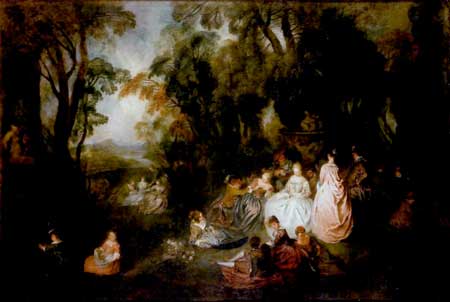
Jean-Baptiste Pater, Fête galante, 128.3 x 192.4 cm. Berlin, Schloss Charlottenburg
If anything, a far more convincing case can be made for links with Pater’s oeuvre—the characters, their triangular massing, the composition opening to a distant landscape, the sculpture, and the buildings pictured there. Specifically, the Chicago painting is directly related to a substantially larger Pater painting, a fête galante in Sanssouci. The two paintings share almost all the same foreground figures save for some minor differences. For example, whereas the man standing at the right side of the Chicago painting turns to confront the viewer (with an expression much more typical of Pater than Watteau), the same figure in the Berlin painting turns to the assembled characters. Likewise, the women seated on the ground to the left of the main group are different. Because the German version is larger, it has more figures in the middleground. None of these differences prove anything about the works’ authorship. Vogtherr viewed the Chicago painting as a possible model for the one in Berlin, and questioningly attributed the Chicago painting to Watteau. Feinberg and Zuccari claimed that the Charlottenburg picture is a copy after a lost variant of the Chicago painting, but without ascribing the supposed lost variant or the German version to a specific artist. Stylistically, there is nothing that distinguishes the two extant paintings from each other. Rather, and far simpler, they are two versions of essentially the same composition by one artist. Both are by Pater.
Prior to 1998 and the realization that the painting sold in 1778 and 1779 under both Watteau’s and Pater’s names, the idea of pictures begun by Watteau and finished by his assistant fascinated scholars. These seemingly documented example of master and pupil working as an ensemble loomed significant. But, alas, we were fooled by the machinations of the eighteenth-century art market. Nonetheless, there are other instances that remain germane, notably the Mariée de village and the Assemblée près d’un statue de Neptune in Madrid, both executed by Watteau with the assistance of Quillard, and the Portrait d’Antoine de la Roque, executed by Watteau and Lancret. These works should encourage us to explore further the absorbing question of the relationship between Watteau and Pater.
